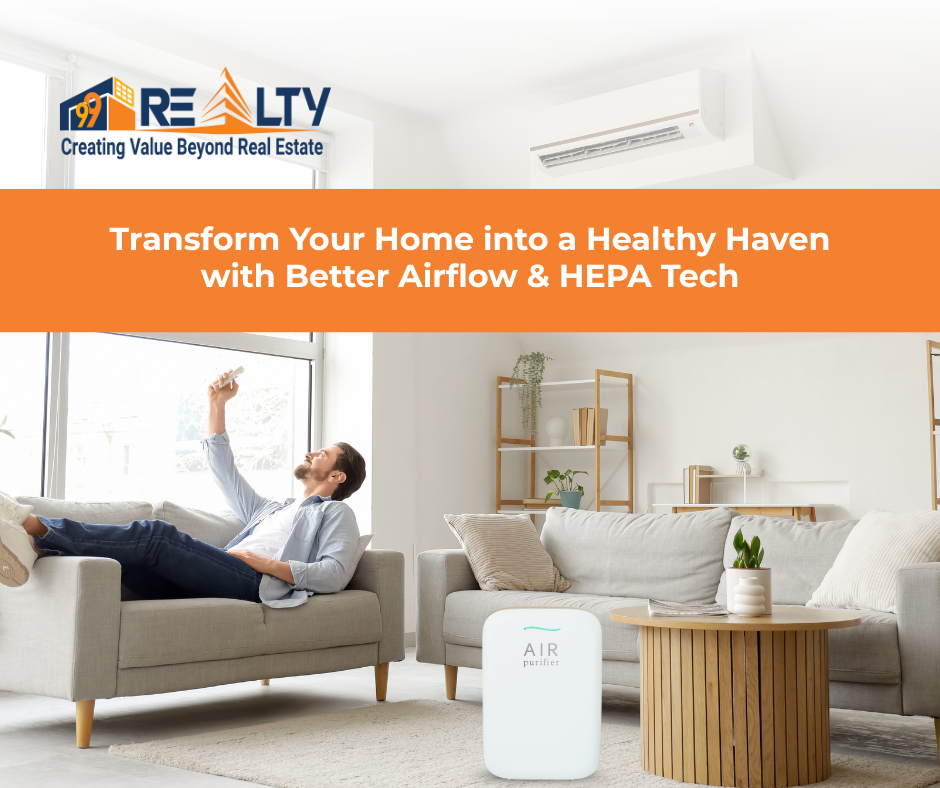When the air inside your home feels heavy, stale, or suffocating, that’s your room crying out for better air circulation. And with the AQI in many parts of the country hitting alarming levels recently, ensuring fresh, clean indoor air isn’t just a good habit—it’s an essential survival skill. Let’s break down practical, everyday tips to boost air circulation and understand why HEPA air purifiers have become a household necessity in 2025.
GRAP Stage III in Delhi-NCR: What the New Restrictions Mean
Why Air Circulation Matters More Than Ever
We often assume that merely staying indoors protects us from pollution. But here’s the truth: indoor air can be 2–5 times more polluted than outdoor air, especially when rooms lack ventilation.
The Link Between Ventilation and Health
Good airflow removes stagnant air, reduces pollutants, regulates humidity, and improves oxygen levels. Poor circulation, on the other hand:
- Traps viruses and bacteria
- Allows dust and allergens to build up
- Causes respiratory irritation
- Makes your home feel stuffy and uncomfortable
Basically, breathing in poorly circulated air is like drinking water from a glass that’s been sitting for three days.
Rising AQI Levels: A Wake-Up Call
With AQI levels crossing 300+ in several cities lately, pollution is no longer an “outdoors-only problem.” Pollutants seep into your home through doors, windows, and even ventilation gaps. That’s why you need a solid combination of smart ventilation and air purification.
Why Tier 2 and Tier 3 Cities Are the New Investment Frontiers
Signs Your Room Has Poor Air Circulation
Before you fix anything, you need to know what’s broken.
– Persistent Odors
If smells—sweat, food, dampness—linger for hours, your air isn’t moving.
– Increased Humidity & Dampness
Foggy windows or peeling wall paint? That’s trapped moisture.
– Dust Accumulation
Dust settling too quickly is your air screaming for help.
Simple Tips to Improve Air Circulation in Any Room
Improving ventilation doesn’t always require a renovation. Sometimes, it’s just about rearranging a few things.
1. Open Windows the Right Way
Opening windows helps, but how you open them matters.
Cross-Ventilation Technique
Open two windows opposite each other. This creates a natural wind tunnel that pushes stale air out and pulls fresh air in.
Timing According to AQI Levels
When AQI is high outside, opening windows all day is risky.
Check real-time AQI apps and ventilate during the lowest hours—usually early morning or late night.
2. Use Exhaust Fans Strategically
Whether in the kitchen or bathroom, exhaust fans yank stale or polluted air out. Use them for:
- Removing smoke
- Clearing humidity
- Pulling out odors
3. Rearrange Furniture to Let Air Flow Freely
If a sofa blocks your window or a cupboard blocks your vent, air circulation takes a hit.
Keep large items at least 3–4 inches away from walls.
4. Switch to Lighter Curtains or Blinds
Heavy curtains look royal but act like air-flow blockers. Lighter fabrics = better breathing room.
5. Add Indoor Plants (But Not Too Many)
Plants like peace lilies and snake plants improve air quality.
But overdoing plants increases humidity and mold risk. Moderation is key.
Advanced Ways to Boost Air Circulation
When simple methods aren’t enough, try these.
1. Use Ceiling, Table, and Tower Fans Efficiently
Fans don’t cool the air—they move it.
Combine fans with open windows to turbocharge ventilation.
2. Install an Air Vent or Duct
If a room feels suffocating, adding a vent or duct can change everything. It’s especially useful in older houses or closed apartments.
3. Keep Doors Open (When Safe)
Closed doors trap air. Keeping them open—even slightly—lets air mix with the rest of the home.
4. Clean Vents, Fans, & Filters Regularly
Dust builds up on blades, grills, and filters.
A dusty fan pushes… more dust.
Clean them monthly.
The Role of HEPA Air Purifiers in Today’s High-AQI Environment
Let’s talk about the real hero of modern indoor air: HEPA air purifiers.
What Exactly Is a HEPA Filter?
HEPA stands for High-Efficiency Particulate Air.
It traps 99.97% of particles as small as 0.3 microns—including dust, pollen, bacteria, smoke particles, PM2.5, and PM10.
That’s smaller than the width of a human hair divided 300 times.
Why HEPA Purifiers Matter More in 2025
As AQI rises, simply ventilating your house becomes tricky.
You can’t open windows freely when the outside air is toxic.
This is where HEPA purifiers balance the equation—they clean indoor air even when ventilation is limited.
How a Purifier Helps Even With Good Ventilation
A HEPA purifier does what ventilation alone cannot:
- Removes microscopic pollutants
- Reduces PM2.5 & PM10 from indoor air
- Lessens asthma and allergy triggers
- Keeps air fresh even in closed rooms
- Works round the clock
Think of ventilation as bringing fresh air in.
Think of HEPA purifiers as filtering that air.
Together, they create the perfect environment.
Ideal Placement for Maximum Efficiency
Place your air purifier:
- In the center of the room or a high-airflow corner
- Away from walls
- At least 2 feet above ground
- Away from obstacles
For maximum effect, keep doors and windows closed while it runs.
Everyday Habits That Improve Indoor Air Quality
These small habits make a big difference.
Avoid Burning Incense, Candles, or Smoking Indoors
They release particulate matter and toxic chemicals.
Keep Your Home Dust-Free
A quick wipe daily prevents buildup.
Wash Fabrics Frequently
Bedsheets, curtains, cushions—all trap pollutants.
Final Thoughts
Improving air circulation isn’t rocket science—it’s about understanding how air behaves in your space and taking small, smart steps to guide it. In a country where AQI levels are rising year after year, depending only on windows and fans isn’t enough anymore.
A HEPA air purifier isn’t a luxury today—it’s protection, wellness, and peace of mind bundled into one device.
The combination of good ventilation + proper airflow + air purification creates a healthier, fresher, and safer living environment. And honestly, your lungs deserve nothing less.
FAQs
1. Can I use a HEPA purifier and keep windows open at the same time?
It’s best to keep windows closed while using a purifier, especially during high AQI days. Otherwise, polluted air keeps entering faster than the purifier can clean it.
2. How many hours should a HEPA purifier run daily?
Ideally 8–12 hours a day. During high pollution days, running it continuously is even better.
3. Do indoor plants improve air quality as much as purifiers?
Plants help, but they cannot replace HEPA filters. Their air-cleaning capacity is very limited.
4. How often should I check AQI before ventilating my room?
At least twice a day—morning and evening. Ventilate only during low AQI periods.
5. Does ceiling height affect air circulation?
Yes. Higher ceilings allow better movement of air, while low ceilings may require more fan or purifier support.
Need Help?
Need help evaluating a property or planning your next move in the market?
Reach out to 99 REALTY – your trusted real estate partner for smarter choices.
Subscribe to get updates on our latest posts and market trends.






Join The Discussion